Improving Water Quality in the Wet Tropics, Australia: A Conceptual Framework and Case Study
Abstract
1. Introduction
1.1. Environmental Values, Relevant Guidelines and Water Quality Objectives
1.2. Rationale for Selecting the Tully Basin as the Case Study for this Research
1.3. Community-Based Natural Resources Management
1.4. A Transdisciplinary Research Approach
1.5. Social-Ecological Planning for Improving Water Quality
2. Materials and Methods
2.1. A Conceptual Framework for Revising Freshwater Water Quality Objectives (WQOs) in the Wet Tropics
2.2. Application of the Conceptual Framework in the Tully Basin, Queensland, Australia
2.2.1. Stage 1 of the Conceptual Framework
2.2.2. Stage 2 of the Conceptual Framework
2.2.3. Stage 3 of the Conceptual Framework
2.2.4. Stage 4 of the Conceptual Framework
2.2.5. Stage 5 of the Conceptual Framework
2.2.6. Stage 6 of the Conceptual Framework
3. Results
3.1. Community Values and Perceptions of Local Water Bodies
3.2. Biophysical Knowledge
3.3. Rationale and Development for a Pilot Water Quality Monitoring Program
- Federal and State of Queensland Water Quality Guidelines: Australian Government guidelines state that locally relevant water quality guidelines should be developed for in-stream water quality protection. In addition, local authorities should use their own tools to better refine these guidelines, either by developing regional guidelines or developing specific local WQOs.
- Tully Water Quality Improvement Plan (WQIP 2008): The basin community had issues of concern regarding freshwaters. The community supported setting Water Quality Objectives (WQOs) to protect Environmental Values (EVs) for freshwaters.
- Water Quality Data and Reports Indicated Potential Water Quality Issues in the Basin. There was no comprehensive water quality sampling network in the basin. Current water quality sampling schemes were patchy; and did not consider seasonality and different flow regimes.
- Workshops and Interviews from this Research. There were continuing community concerns about water quality issues, and input from the community indicated they would like to be involved in a pilot water quality monitoring program.
- Key results from the interview data were compared to biophysical data for this basin. Social and biophysical results informed each other and indicated that additional data were needed to refine WQOs for this basin.
3.4. Development of a Pilot Water Quality Monitoring Program for the Tully Basin
3.5. Water Quality Sampling Methodology
3.6. Factors Supporting and/or Inhibiting Refinement of WQOs
4. Discussion
Challenges of Community Participation and Knowledge Integration
- (1)
- Conflicts between stakeholder groups regarding consumptive and non-consumptive water uses and intrinsic values,
- (2)
- A lack of sustained stakeholder participation, unequal knowledge-power dynamics, and
- (3)
- Biases in local and scientific knowledge contributions.
5. Conclusions
Author Contributions
Funding
Acknowledgments
Conflicts of Interest
Appendix A. Table of Environmental Values (EVs) * Summarised for the Tully Basin
| Water Uses and Values/Location | EVs |  |  |  |  |  |  |  |  |  |  |  |  |
| Aquatic ecosystems | Irrigation | Farm Supply | Stock Watering | Aquaculture | Human Consumption | Primary Recreation | Secondary Recreation | Visual | Drinking Water | Industrial Use | Spiritual and Cultural Values | ||
| Hull River/Coastal Tributaries (freshwaters) (undeveloped) |  |  |  |  |  |  |  | ||||||
| Hull River/Coastal Tributaries (freshwaters) (developed) |  |  |  |  |  |  |  |  | |||||
| Hull River natural wetlands |  |  |  | ||||||||||
| Tully (undeveloped) |  |  |  |  |  |  |  | ||||||
| Tully (developed) |  |  |  |  |  |  |  |  |  |  |  | ||
| Koombooloomba Dam |  |  |  |  |  |  |  |  | |||||
| Tully natural and constructed wetlands |  |  |  |  |  |  |  |  |  | ||||
| Tully upstream tidal limit to estuary |  |  |  |  |  |  | |||||||
| Murray River (undeveloped) |  |  |  |  |  |  |  | ||||||
| Murray River (developed) |  |  |  |  |  |  |  |  |  |  | |||
| Murray natural and constructed wetlands |  |  |  |  |  |  |  |  | |||||
| Murray upstream tidal limit to estuary |  |  |  |  |  | ||||||||
| Marine | Inshore marine (mouth estuary to marine waters) |  |  |  |  |  |  |  | |||||
| Inshore marine (all marine waters < 15 km from coast) |  |  |  |  |  |  | |||||||
| Offshore marine |  |  |  |  |  |  |
 * EVs selected for protection; blank indicates EV was not chosen for protection. Table does not include EVs identified from this research that are outside the suite of EVs in the Queensland Water Quality Guidelines (EPA 2013).
* EVs selected for protection; blank indicates EV was not chosen for protection. Table does not include EVs identified from this research that are outside the suite of EVs in the Queensland Water Quality Guidelines (EPA 2013).Appendix B. Water Quality Sampling Station Locations in the Tully Basin Subcatchments
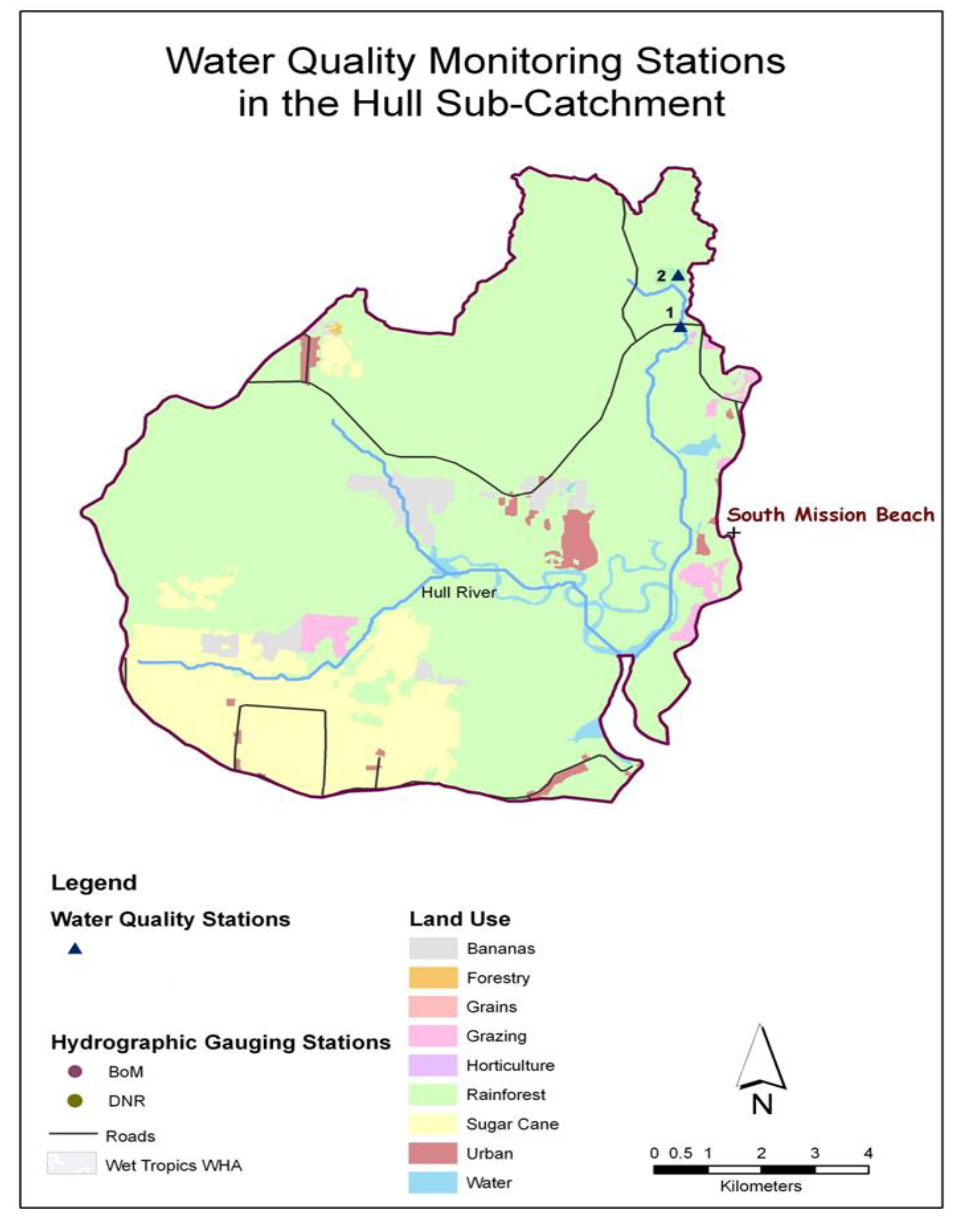
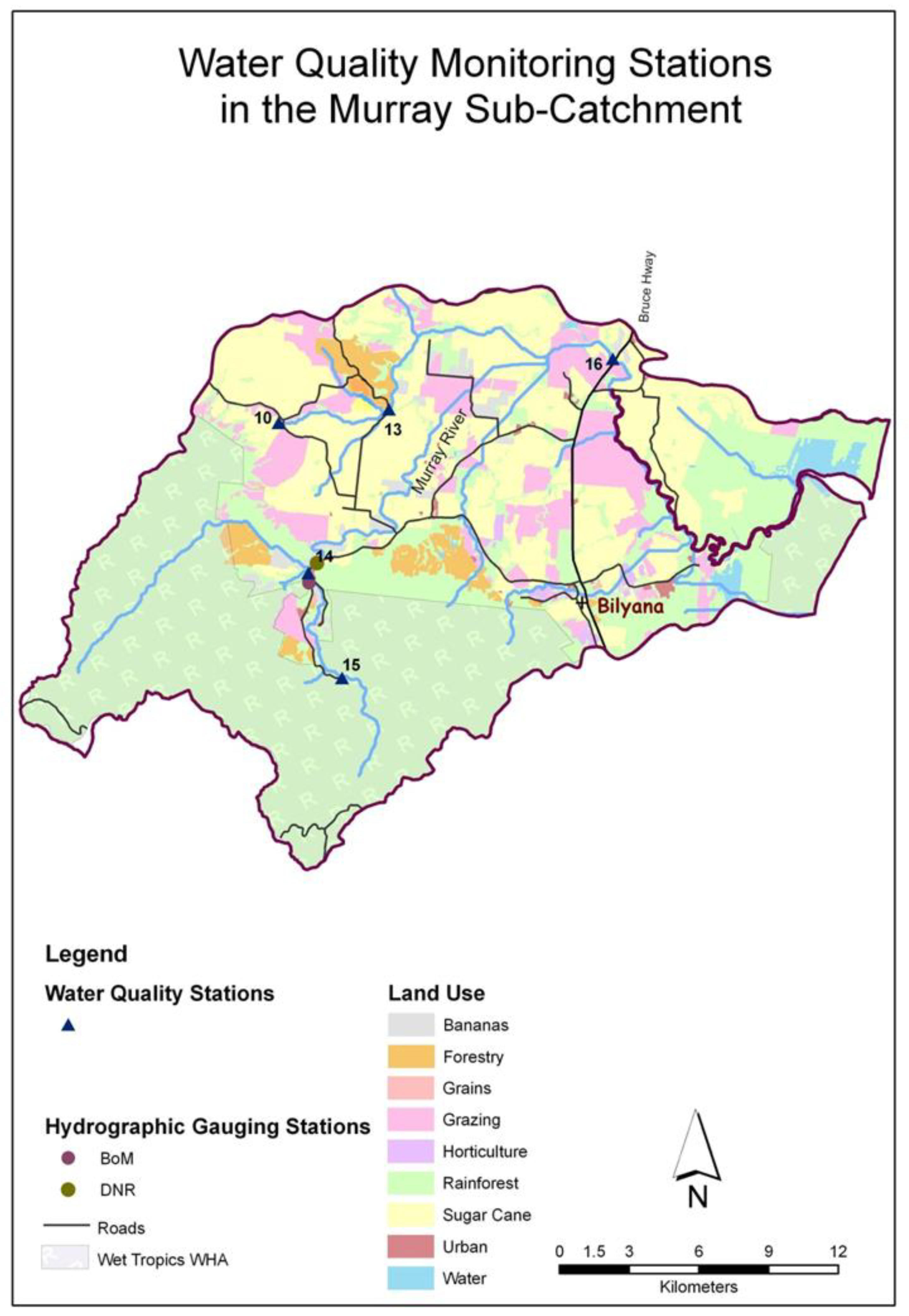
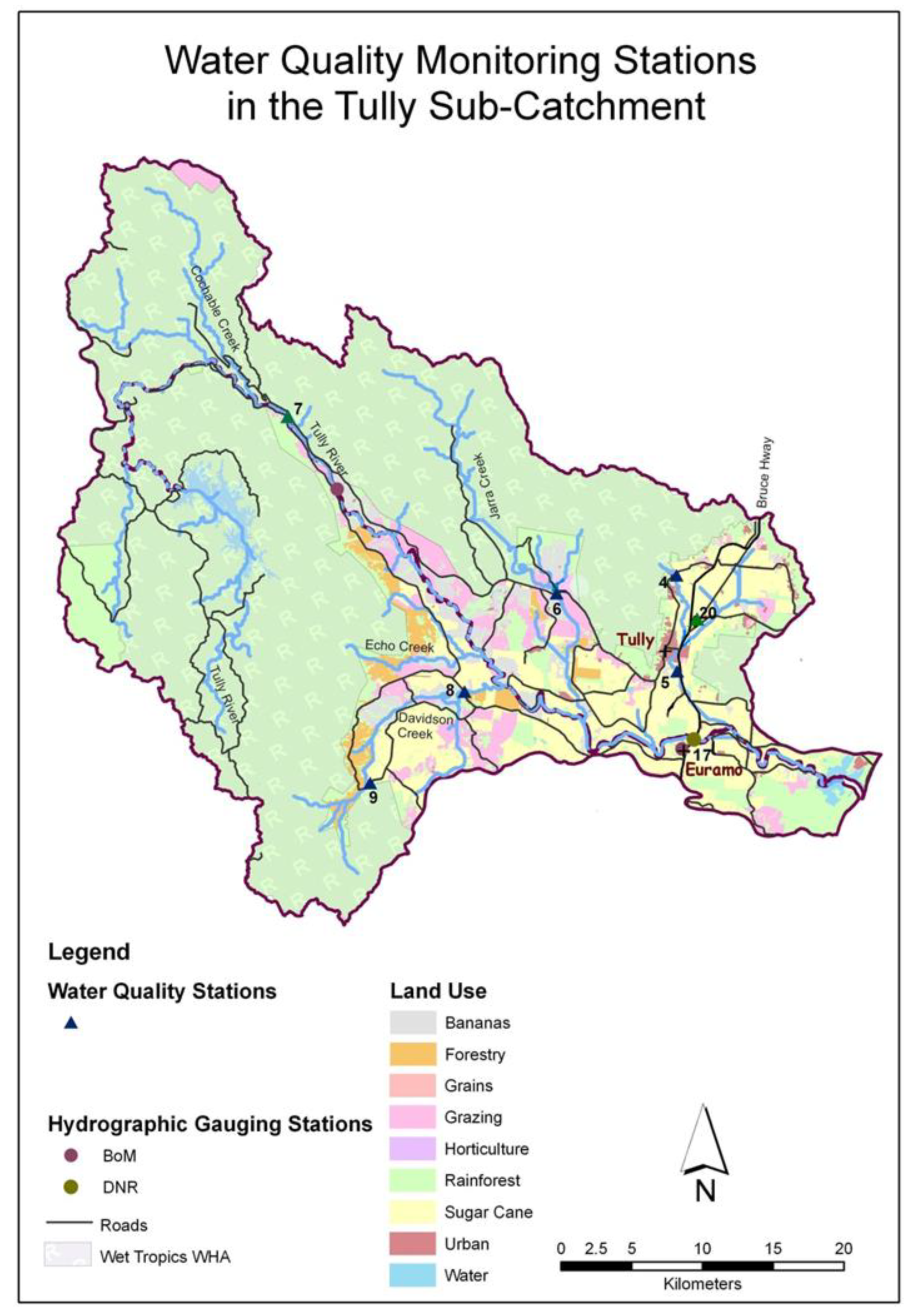
Appendix C. Results from Interviews
Appendix C.1. General Information
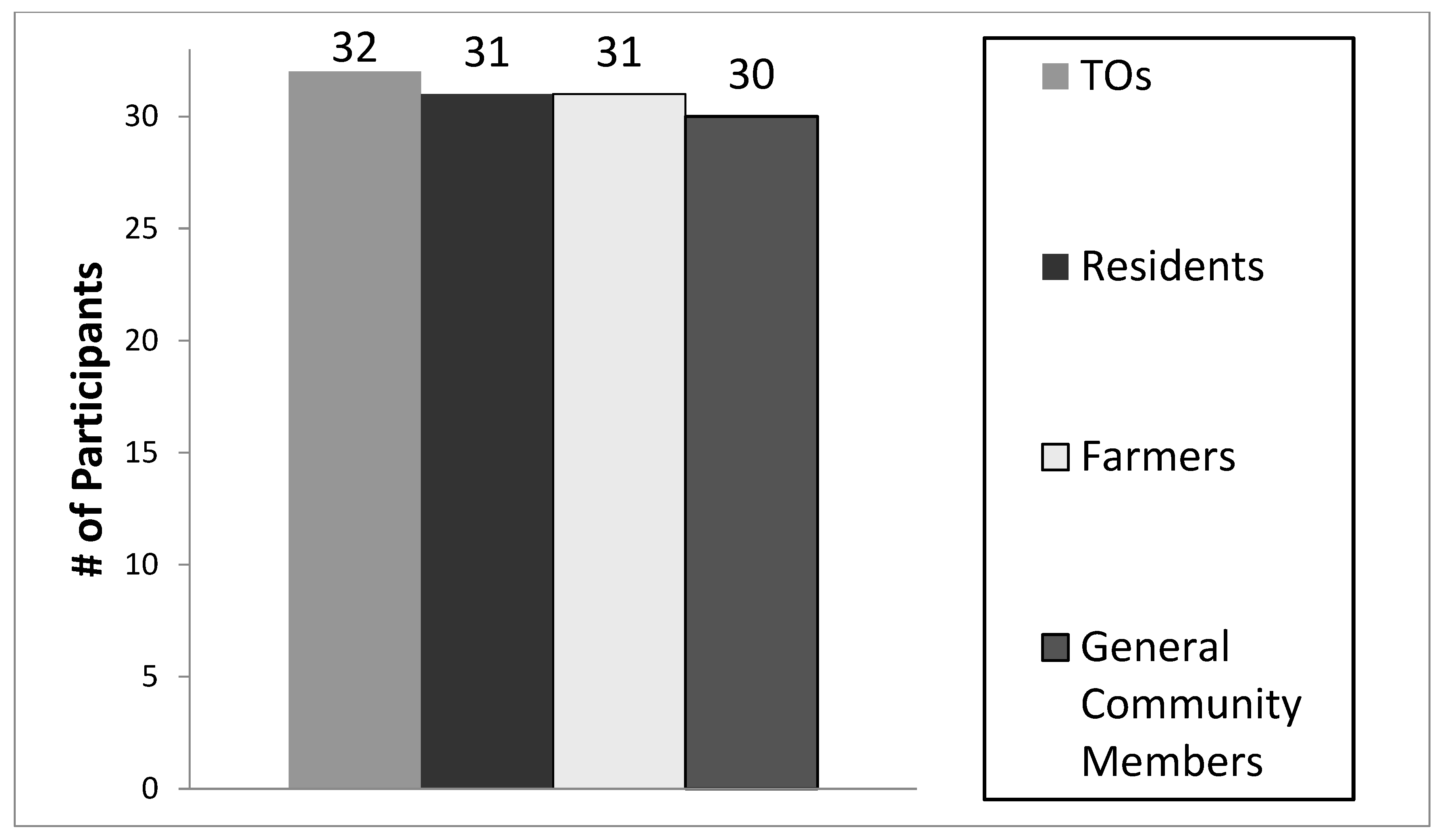
| Traditional Owners | Residents | Farmers | General Community Members * | ||
|---|---|---|---|---|---|
| Gender | |||||
| Male | 22 | 15 | 28 | 20 | |
| Females | 10 | 16 | 3 | 10 | |
| Total | 32 | 31 | 31 | 30 | |
| Age (years) | |||||
| <21 | 3 | 1 | 0 | 0 | |
| 21–30 | 6 | 0 | 0 | 2 | |
| 31–40 | 7 | 7 | 4 | 9 | |
| 41–50 | 7 | 2 | 6 | 4 | |
| 51–60 | 7 | 10 | 5 | 8 | |
| >60 | 2 | 11 | 16 | 7 | |
| Total | 32 | 31 | 31 | 30 | |
| Length of Time Lived in the Basin (years) | |||||
| <10 | 2 | 4 | 2 | 5 | |
| 10–20 | 4 | 9 | 4 | 1 | |
| 21–30 | 6 | 4 | 3 | 0 | |
| >30 | 20 | 14 | 22 | 2 | |
| Total | 32 | 31 | 31 | 8 | |
| Interviewee’s Primary Residence (#s of interviewees per location) | |||||
| Tully Basin | 37 | ||||
| Murray Basin | 44 | ||||
| Hull Basin | 21 | ||||
| Outside Basin | 22 | ||||
| Total | 124 | ||||
Appendix C.2. EV Verification
- Drinking water
- Aquatic ecosystems
- Recreational opportunities and aesthetic qualities
- Cultural and spiritual values and access to those sites
- Primary production and associated industries
Appendix C.3. Additional EVs to be Added
Appendix C.3.1. Summary of Additional EVs to be Added that Can Be Categorised by the Guidelines
- Cultural and spiritual values
- Human use EVs (consumption of wild or stocked fish/crustaceans, irrigation, farm use, stock watering and aquaculture)
- Recreation and aesthetics EVs (water for primary and secondary recreation and visual appreciation)
- Raw drinking water supply
- Aquatic ecosystems
Appendix C.3.2. Summary of Additional EVs to Be Added that Are Outside the List of Established EV Categories
- Community development (knowledge sharing) uses and values
- Groundwater values
- Flooding values
- Conservation values
- Tourism values
- Lost EVs

Appendix C.4.Water Quality

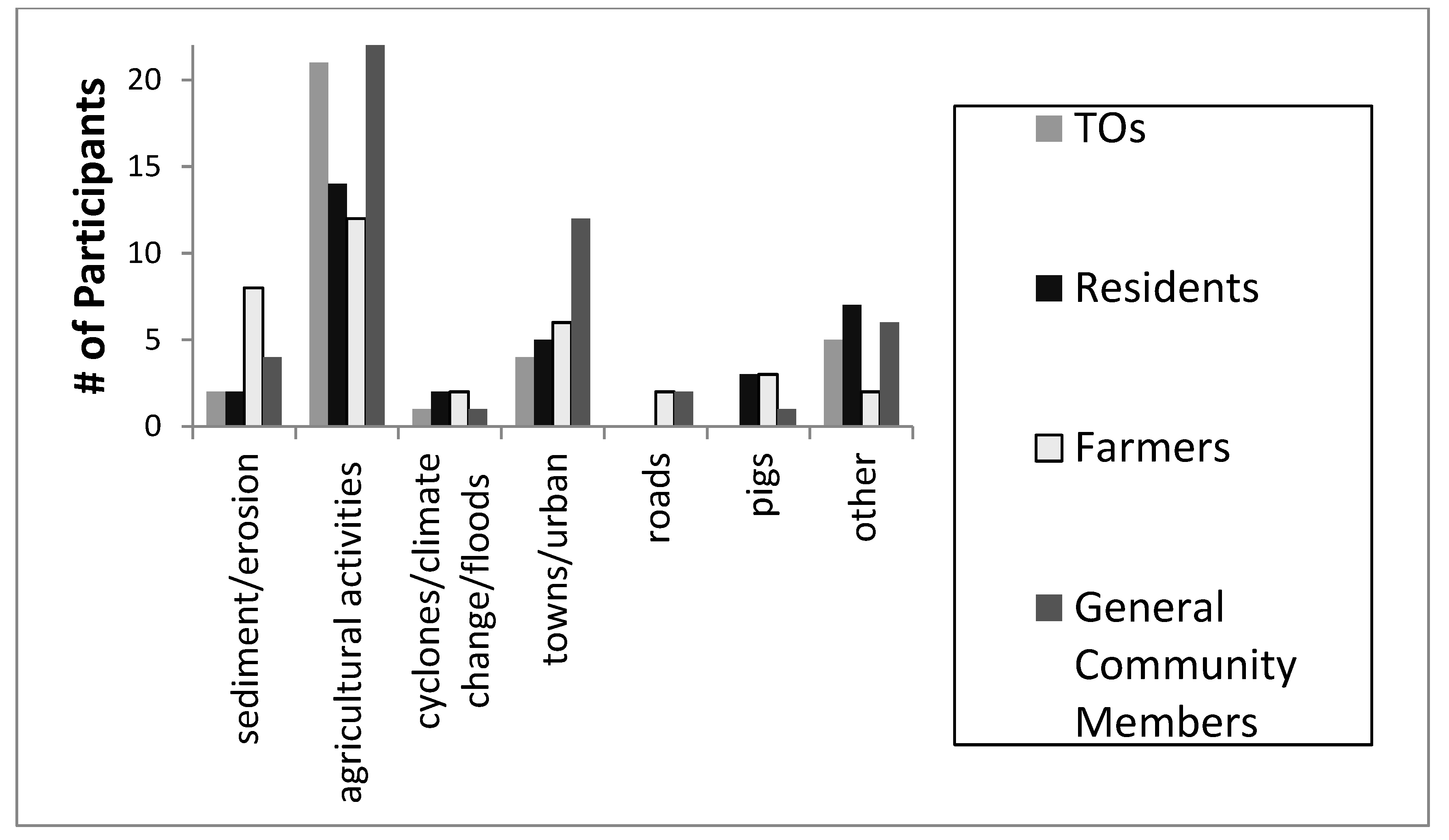
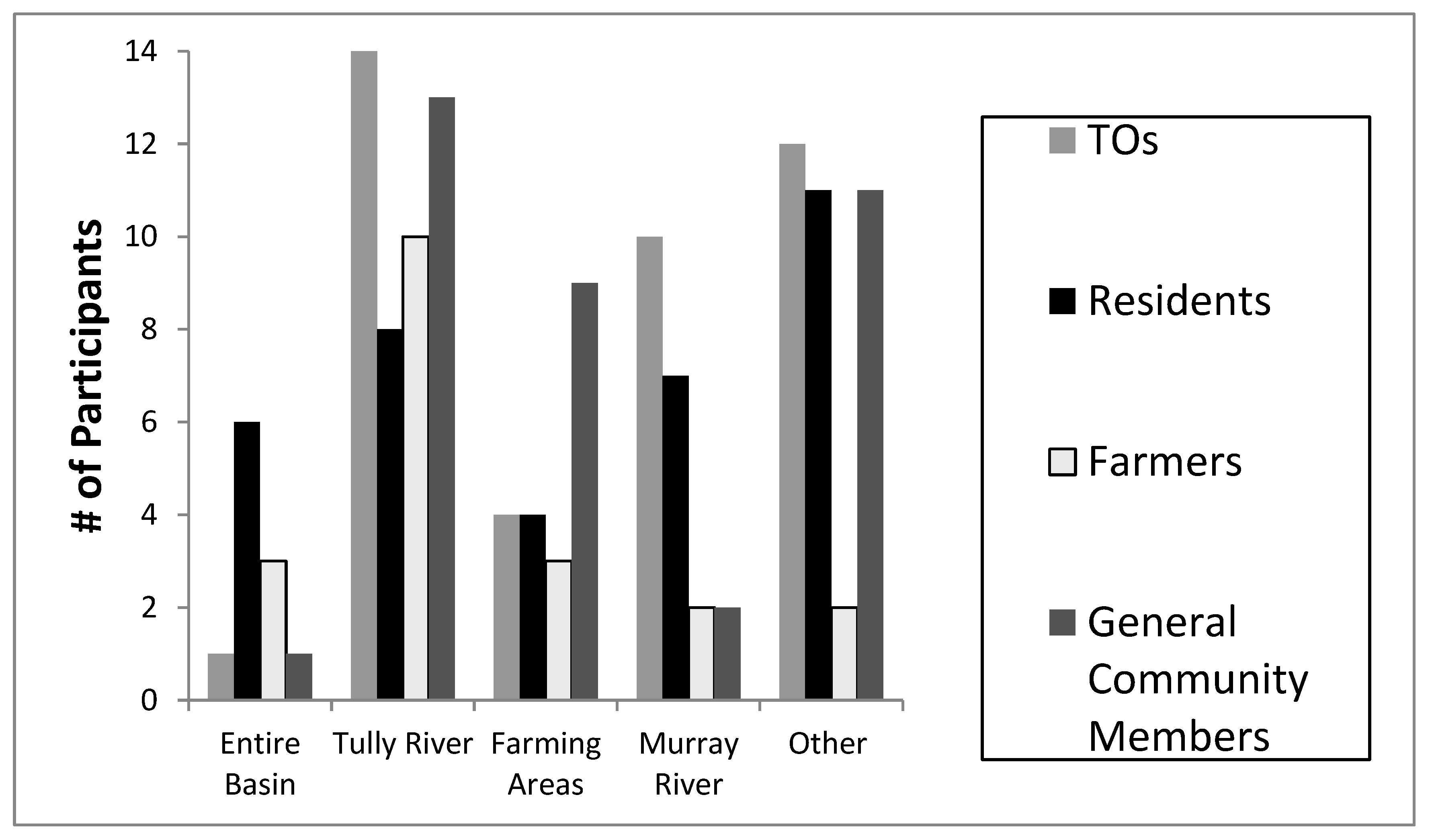

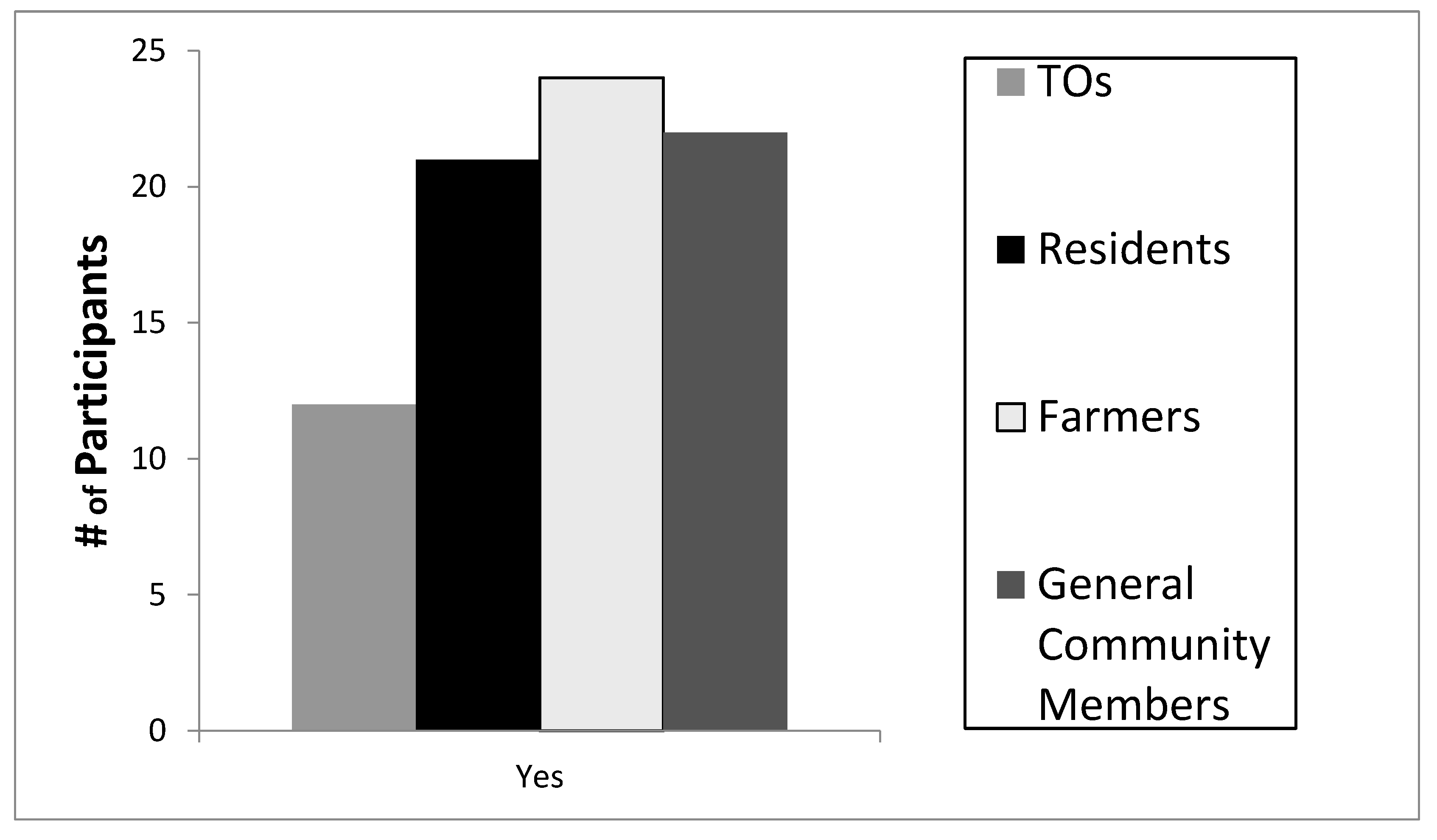
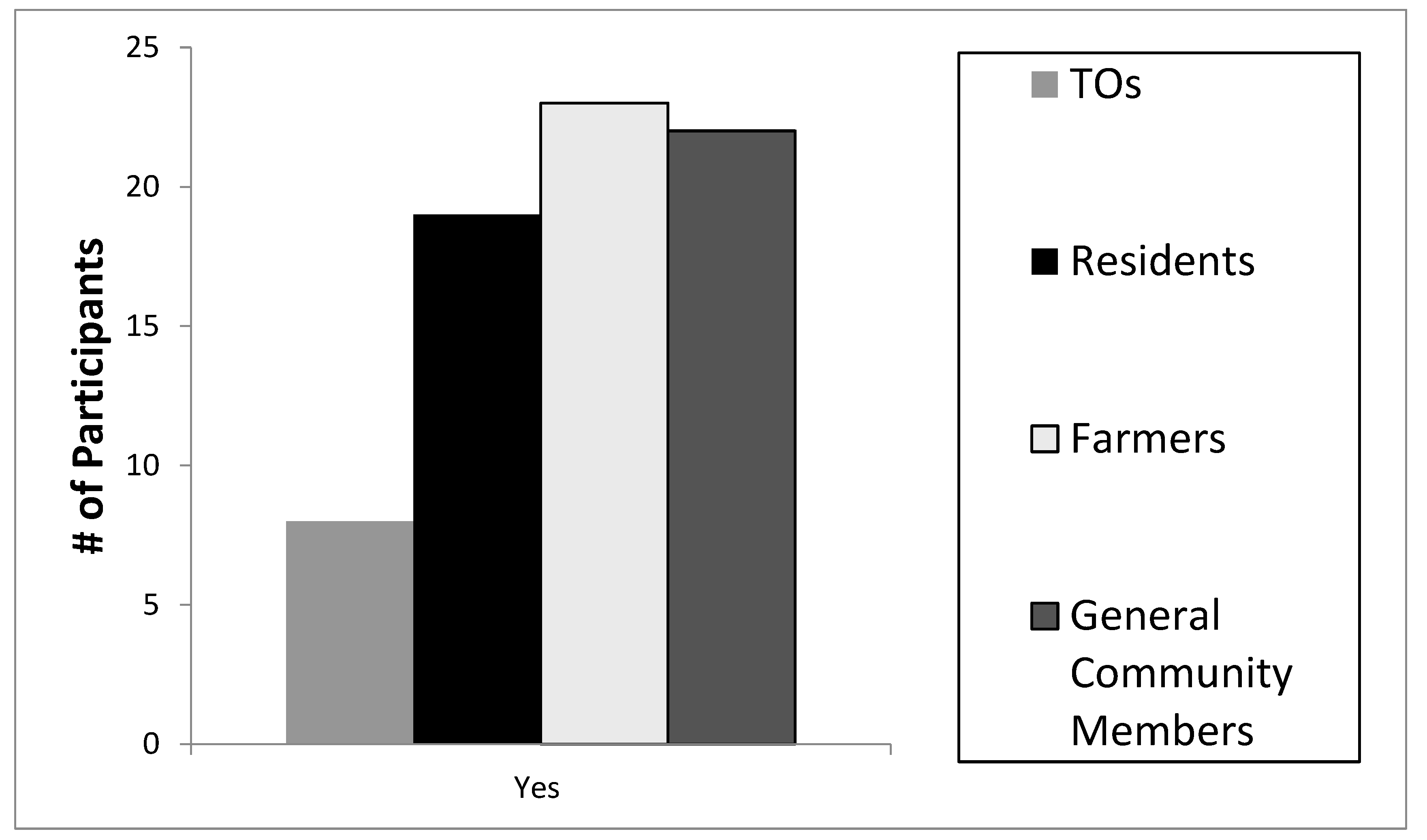

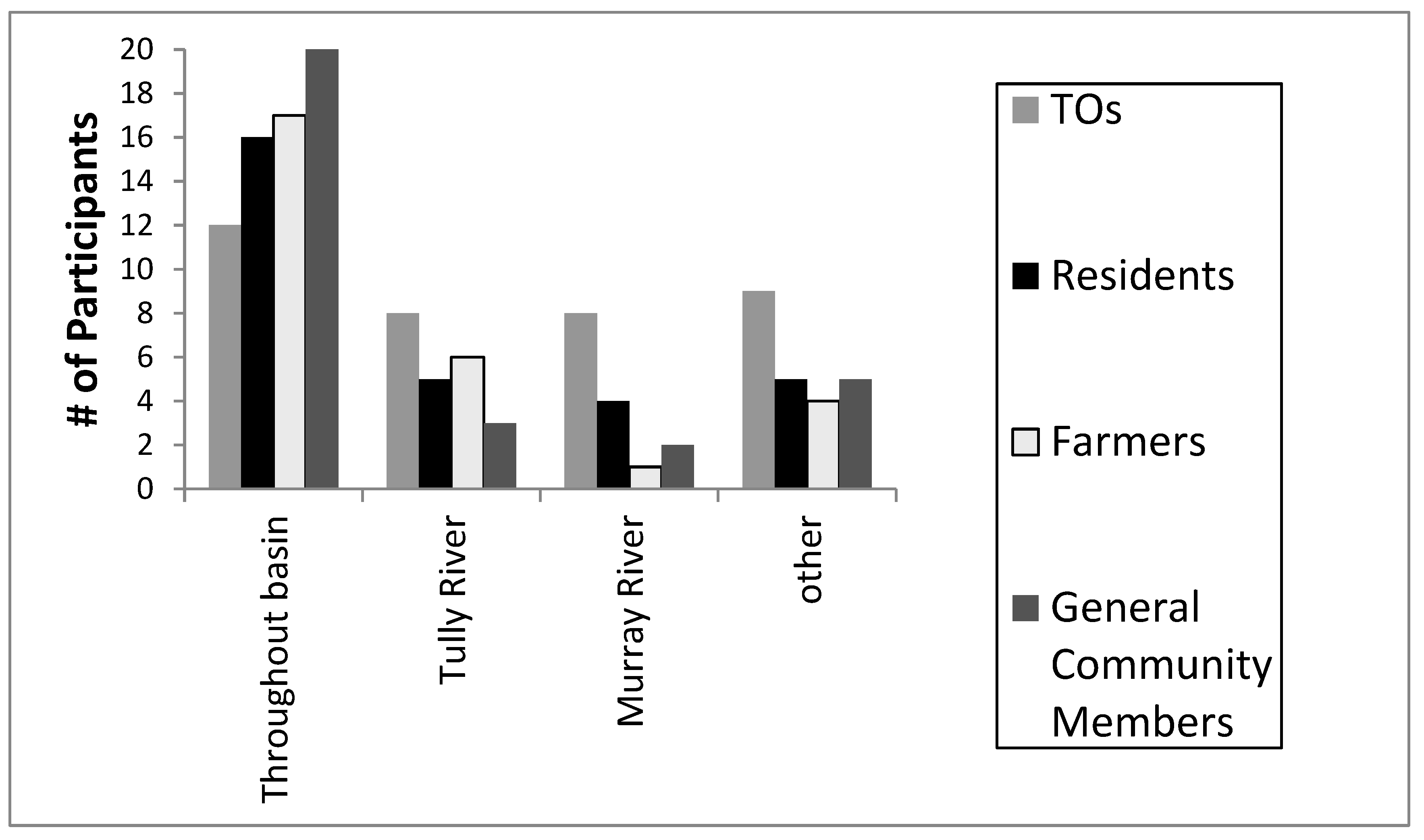
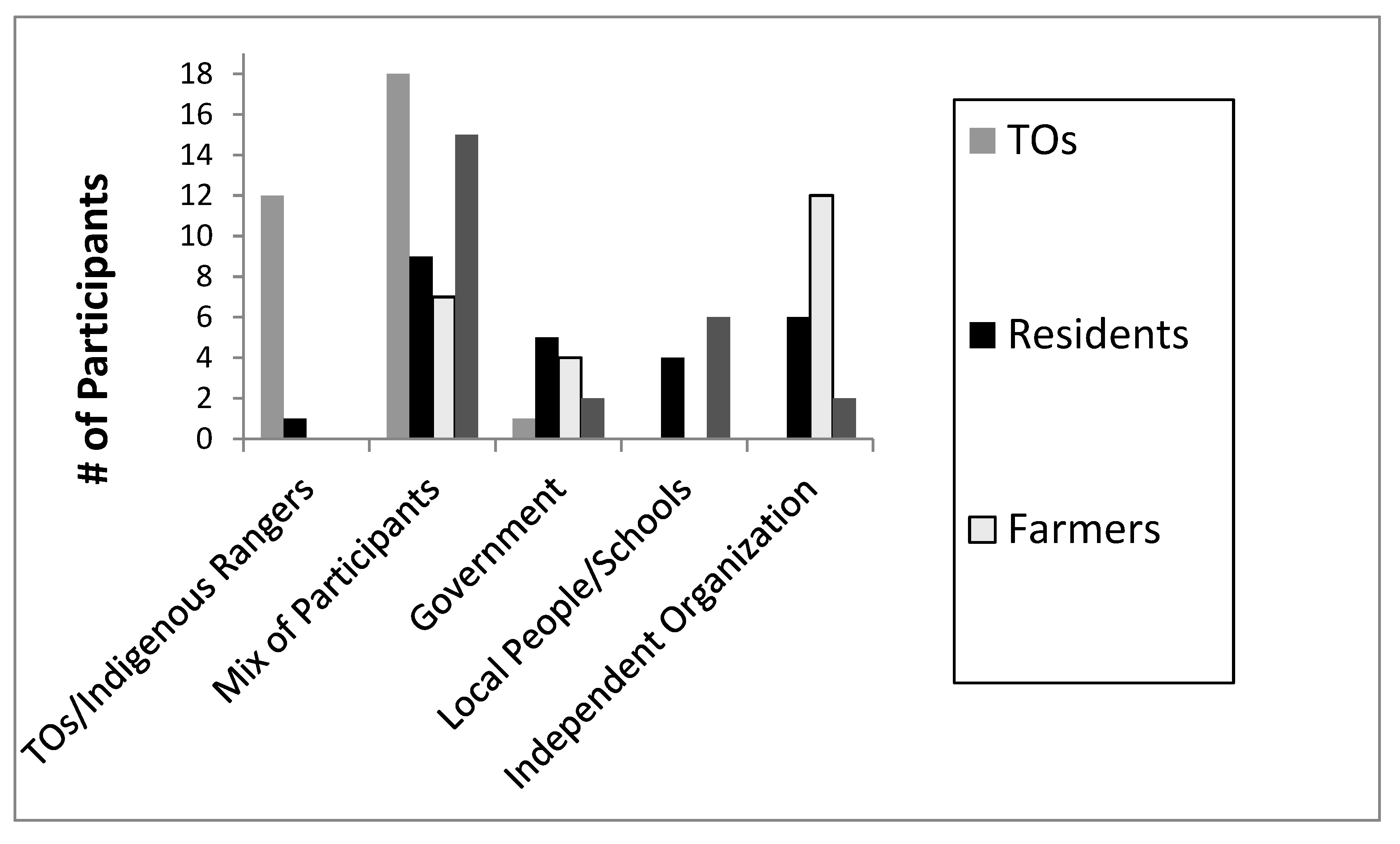
Appendix C.5. Summary of the Key Interview Results
References
- McDonald, G.; Weston, N. Sustaining the Wet Tropics: A Regional Plan for Natural Resource Management. Background to the Plan; Rainforest CRC and FNQ NRM Ltd.: Cairns, Australia, 2004. [Google Scholar]
- Bohnet, I.; Smith, D.M. Planning future landscapes in the Wet Tropics of Australia: A social-ecological framework. Landsc. Urban Plan. 2007, 80, 137–152. [Google Scholar] [CrossRef]
- Terrain, N.R.M. Wet Tropics Water Quality Improvement Plan: 2015–2020. Available online: https://terrainnrm.maps.arcgis.com/apps/MapSeries/index.html?appid=a0184c53739c482496b42cca599a89c2 (accessed on 28 August 2020).
- Department of Environment, Water, Heritage, and the Arts (DEWHA). Caring for Our Country Outcomes 2008–2013; DEWHA: Canberra, Australia, 2009. [Google Scholar]
- Terrain, N.R.M. Summary of the Tully Water Quality Improvement Plan. Available online: www.terrain.org.au (accessed on 28 August 2020).
- Brodie, J.; Mitchell, A. Sediments and Nutrients in North Queensland Tropical Streams: Changes with Agricultural Development and Pristine Condition Status; CRC Reef Research Centre: Townsville, Australia, 2006; pp. 81–100. [Google Scholar]
- Tsatsaros, J.H.; Brodie, J.E.; Bohnet, I.C.; Valentine, P. Water Quality Degradation of Coastal Waterways in the Wet Tropics, Australia. Water Air Soil Pollut. 2013, 224, 1443. [Google Scholar] [CrossRef]
- Australian Government. Reef 2050 Water Quality Improvement Plan 2017–2022. 2018. Available online: https://www.reefplan.qld.gov.au/__data/assets/pdf_file/0017/46115/reef-2050-water-quality-improvement-plan-2017-22.pdf (accessed on 28 August 2020).
- Schulz, Martin-Ortega & Glenk. Value landscapes and their impact on public water policy preferences. Glob. Environ. Chang. 2018, 53, 209–224. [Google Scholar] [CrossRef]
- State of Queensland, Department of Environment and Heritage Protection (EHP). Queensland Water Quality Guidelines 2009. 2013. Available online: https://www.hort360.com.au/wordpress/uploads/Irrigation/Irrigation%20Sustainability/Qld%20Water%20Quality%20Guidelines%202009.pdf (accessed on 26 September 2020).
- Australian Government Charter. National Water Quality Management Strategy; CCBY3.0; Department of Agriculture and Water Resources: Canberra, Australia, 2018. Available online: https://www.waterquality.gov.au/sites/default/files/documents/nwqms-charter.pdf (accessed on 26 September 2020).
- State of Queensland, Environmental Policy and Planning Division, Department of Environment and Heritage Protection. Environmental Protection (Water) Policy 2009 Tully, Murray and Hinchinbrook Is. River Basins Environmental Values and Water Quality Objectives—Basins Nos. 113, 114 and 115 and Adjacent Coastal Waters. 2014. Available online: https://environment.des.qld.gov.au/__data/assets/pdf_file/0020/89012/tully-murray-hinchinbrook-evs-wqos.pdf (accessed on 26 September 2020).
- Lewis, S.E.; Brodie, J.E. A Water Quality Issues Analysis for the Johnstone River Basin; Report # 11/05 for Terrain NRM; Australian Centre for Tropical Freshwater Research, James Cook University: Townsville, Australia, 2011. [Google Scholar]
- Lewis, S.E.; Brodie, J.E. A Water Quality Issues Analysis for the Mulgrave River Catchment; Report #11/06 for Terrain NRM; Australian Centre for Tropical Freshwater Research, James Cook University: Townsville, Australia, 2011. [Google Scholar]
- Lewis, S.E.; Brodie, J.E. A Water Quality Issues Analysis for the Russell River Catchment; Report # 11/07 for Terrain NRM; Australian Centre for Tropical Freshwater Research, James Cook University: Townsville, Australia, 2011. [Google Scholar]
- Kroon, F.J.; Brodie, J.E. Catchment management and health of coastal ecosystems: Synthesis and future research. Mar. Freshw. Res. 2009, 60, 1196–1200. [Google Scholar] [CrossRef]
- Moss, A.; Brodie, J.; Furnas, M. Water quality guidelines for the Great Barrier Reef World Heritage Area: A basis for development and preliminary values. Mar. Freshw. Res. 2005, 51, 76–88. [Google Scholar] [CrossRef]
- Tsatsaros, J.H. Refining Water Quality Objectives and Monitoring in the Wet Tropics Using a Community Based Approach. Ph.D. Thesis, James Cook University, Townsville, Australia, 2013. [Google Scholar]
- Bohnet, I.; Kinjun, C. Community uses and values of water informing water quality improvement planning: A study from the Great Barrier Reef region, Australia. Mar. Freshw. Res. 2009, 60, 1176–1182. [Google Scholar] [CrossRef]
- Tsatsaros, J.H.; Brodie, J.E.; Bohnet, I.C.; Valentine, P. A Trans-Disciplinary Approach for Refining Water Quality Objectives in the Wet Tropics, Australia. In Peer-Reviewed Conference Paper. Transboundary Water Management Across Borders and Interfaces (TWAM) International Conference and Workshops–Conference Proceedings; Roebeling, P.C., Rocha, J., Teotónio, C., Alves, H., Almeida, P., Eds.; CESAM–Department of Environment & Planning, University of Aveiro: Aveiro, Portugal, 2013; ISBN 978-972-789-378-2. [Google Scholar]
- Bohnet, I.; Kinjun, C.; Roberts, B. Community Uses and Values in Waters in the Tully-Murray Catchment; First Milestone Report for Far North Queensland Natural Resources Management (FNQ NRM): Canberra, Australia, 2006. [Google Scholar]
- Bohnet, I.; Kinjun, C.; Haug, K.; Kroon, F.; Sydes, D.; Pert, P.; Roberts, B. Community Uses and Values in Waters in the Tully-Murray Catchment; Final Report for Far North Queensland Natural Resource Management (FNQ NRM Ltd.): Cairns, Australia, 2007. [Google Scholar]
- Faithful, J.; Brodie, J.; Bainbridge, Z.; Schaffelke, B.; Slivkoff, M.; Maughan, M.; Liessmann, L.; Sydes, D. Water Quality Characteristics of Water Draining Different Land Uses in the Tully/Murray Rivers Region-Edition 2 for the Terrain Water Quality Improvement Plan; ACTFR Report: No. 08/03; James Cook University: Townsville, Australia, 2008. [Google Scholar]
- Devlin, M.; Schaffelke, B. Spatial extent of riverine flood plumes and exposure of marine ecosystems in the Tully coastal region, Great Barrier Reef. Mar. Freshw. Res. 2009, 60, 1109–1122. [Google Scholar] [CrossRef]
- Webster, A.J.; Thorburn, P.J.; Roebeling, P.C.; Horan, H.L.; Biggs, J.S. The expected impact of climate change on nitrogen losses from wet tropical sugarcane production in the Great Barrier Reef region. Mar. Freshw. Res. 2009, 60, 1159–1164. [Google Scholar] [CrossRef]
- Faithful, J.; Finlayson, W. Water quality assessment for sustainable agriculture in the Wet Tropics-A community assisted approach. Mar. Pollut. Bull. 2005, 51, 99–112. [Google Scholar] [CrossRef]
- Brodie, J.; Lewis, S.; Bainbridge, Z.; Mitchell, A.; Waterhouse, J.; Kroon, F. Target setting for pollutant discharge management of rivers in the Great Barrier Reef catchment area. Mar. Freshw. Res. 2009, 60, 1141–1149. [Google Scholar] [CrossRef]
- Queensland Government Statistician’s Office. Queensland Treasury, Queensland Regional Profiles: Resident Profile for Tully Statistical Area Level 2 (QGSO). 2020. Available online: https://statistics.qgso.qld.gov.au/qld-regional-profiles (accessed on 28 August 2020).
- Gruber, J. Perspectives of effective and sustainable community-based natural resource management: An application of Q methodology to forest projects. Conserv. Soc. 2011, 9, 159–171. [Google Scholar] [CrossRef]
- Carlson, T.; Cohen, A. Linking Community-based monitoring to water policy: Perceptions of citizen scientists. Environ. Manag. 2018, 219, 168–177. [Google Scholar] [CrossRef]
- Hill, R. Towards Equity in Indigenous co-management of protected areas: Cultural planning by Miriuwung-Gajerrong people in the Kimberley, Western Australia. Geogr. Res. 2010, 49, 72–85. [Google Scholar] [CrossRef]
- Wilson, N.J.; Mutter, E.; Inkster, J.; Satterfield, T. Community-based monitoring as the practice of Indigenous governance: A case study of Indigenous-led water quality monitoring in the Yukon River Basin. Environ. Manag. 2018, 210, 290–298. [Google Scholar] [CrossRef]
- Behmel, S.; Damour, M.; Ludwig, R.; Rodriguez, M.J. Participative approach to elicit water quality needs from stakeholder groups-An application of integrated watershed management. J. Environ. Manag. 2018, 218, 540–554. [Google Scholar] [CrossRef] [PubMed]
- Brodie, J.; Kroon, F.; Schaffelke, B.; Wolanski, E.; Lewis, S.; Devlin, M.; Bohnet, I.C.; Bainbridge, Z.; Waterhouse, J.; Davis, A. Terrestrial pollutant runoff to the Great Barrier Reef: Current issues, priorities, and management responses. Mar. Pollut. Bull. 2012, 65, 81–100. [Google Scholar] [CrossRef]
- Bohnet, I.C. Integrating social and ecological knowledge for planning sustainable land- and seascapes: Experiences from the Great Barrier Reef region, Australia. Landsc. Ecol. 2010, 25, 1201–1218. [Google Scholar] [CrossRef]
- Hatfield-Dodds, S.; Syme, G.J.; Leitch, A. Improving Australian water management: The contribution of social values research and community engagement. Reform 2006, 89, 44–48. [Google Scholar]
- Hophmayer-Tokich, S.; Krozer, Y. Public participation in rural area management: Experiences from the North Sea countries in Europe. Water Int. 2008, 33, 243–257. [Google Scholar] [CrossRef]
- Luz, F. Participatory landscape ecology-a basis for acceptance and implementation. Landsc. Urban Plan. 2000, 50, 157–166. [Google Scholar] [CrossRef]
- Evely, A.; Fazey, I.; Pinard, M.; Lambin, X. The influence of philosophical perspectives in integrative research: A conservation case study in the Cairngorms National Park. Ecol. Soc. 2008, 13, 52. [Google Scholar] [CrossRef]
- McLeod, C.; Blackstock, K.; Haygarth, P. Mechanisms to improve integrative research at the science-policy interface for sustainable catchment management. Ecol. Soc. 2008, 13, 48. [Google Scholar] [CrossRef]
- Hochtl, F.; Lehringer, S.; Konold, W. Pure theory or useful tool? experiences with transdisciplinary in the Piedmont Alps. Environ. Sci. Policy 2006, 9, 322–329. [Google Scholar] [CrossRef]
- Tress, G.; Tress, B.; Fry, G. Clarifying integrative research concepts in landscape ecology. Landsc. Ecol. 2005, 20, 479–493. [Google Scholar] [CrossRef]
- Kroon, F.J.; Robinson, C.J.; Dale, A.P. Integrating knowledge to inform water quality planning in the Tully–Murray basin. Australia. Mar. Freshw. Res. 2009, 60, 1183–1188. [Google Scholar] [CrossRef]
- Lang, D.J.; Wiek, A.; Bergmann, M.; Stauffacher, M.; Martens, P.; Moll, P.; Swilling, M.; Thomas, C.J. Transdisciplinary research in sustainability science: Practice, principles, and challenges. Sustain. Sci. 2012, 7, 25. [Google Scholar] [CrossRef]
- Cullen-Unsworth, L.C.; Hill, R.; Butler, J.R.A.; Wallace, M. Development of Linked Cultural and Biophysical Indicators for the Wet Tropics World Heritage Area. Int. J. Sci. Soc. 2011, 2, 181–194. [Google Scholar] [CrossRef]
- Bark, R.H.; Barber, M.; Jackson, S.; Maclean, K.; Pollino, C.; Moggridge, B. Operationalising the ecosystem services approach in water planning: A case study of indigenous cultural values from the Murray–Darling Basin, Australia. Int. J. Biodivers. Sci. Ecosyst. Serv. Manag. 2015, 11, 239–249. [Google Scholar] [CrossRef]
- Lingiari Foundation and the North Australian Indigenous Land and Sea Management Alliance (NAILSMA). An Overview of Indigenous Rights in Water Resources Management; North Australian Indigenous Land and Sea Management Alliance on behalf of the Indigenous Water Policy Group: Darwin, Australia, 2008. [Google Scholar]
- North Australian Indigenous Land and Sea Management Alliance (NAILSMA) and the Commonwealth Scientific and Industrial Research Organization (CSIRO). Indigenous Interests and the National Water Initiative (NWI): Water Management, Reform and Implementation; North Australian Indigenous Land and Sea Management Alliance: Darwin, Australia, 2007. [Google Scholar]
- Swanwick, C. Land Use Consultants, Landscape Character Assessment—Guidance for England and Scotland, The Countryside Agency and Scottish Natural Heritage, Wetherby, West Yorkshire and Edinburgh; The Countryside Agency and Scottish Natural Heritage: Sheffield, UK, 2002. [Google Scholar]
- Kasemir, B.; Jaeger, J.; Jaeger, C.C.; Gardner, M.T. Public Participation in Sustainability Science—A Handbook; Cambridge University Press: Cambridge, UK, 2003. [Google Scholar]
- Bohnet, I.; Brodie, J.; Bartley, R. Assessing water quality impacts of community defined land use change scenarios for the Douglas Shire, Far North. In Landscape Analysis and Visualization; Pettit, C., Cartwright, W., Bishop, I., Lowell, K., Pullar, D., Duncan, D., Eds.; Springer: Berlin, Germany, 2008; pp. 383–406. [Google Scholar] [CrossRef]
- Bohnet, I.C. Lessons Learned from Public Participation in Water Quality Improvement Planning: A Study from Australia. Soc. Nat. Resour. 2015, 28, 180–196. [Google Scholar] [CrossRef]
- Patterson, J.J.; Smith, C.; Bellamy, J. Understanding enabling capacities for managing the ‘wicked problem’ of nonpoint source water pollution in catchments: A conceptual framework. J. Environ. Manag. 2013, 128, 441–452. [Google Scholar] [CrossRef]
- Jager, N.W.; Challies, E.; Kochskamper, E.; Newig, J.; Benson, D.; Blackstock, K.; von Korff, Y. Transforming European Water Governance? Participation and River Basin Management under the EU Water Framework Directive in 13 Member States. Water 2016, 8, 156. [Google Scholar] [CrossRef]
- Kochskamper, E.; Challies, E.; Newig, J.; Jager, N.W. Participation for effective environmental governance? Evidence from Water Framework Directive implementation in Germany, Spain and the United Kingdom. J. Environ. Manag. 2016, 181, 737–748. [Google Scholar] [CrossRef] [PubMed]
- Miles, M.B.; Huberman, A.M. Qualitative Data Analysis, 2nd ed.; Sage: London, UK, 1994. [Google Scholar]
- Guest, G.; MacQueen, K.M. (Eds.) Handbook for Team Based Qualitative Research; Altamira Press: Plymouth, UK, 2008. [Google Scholar]
- Filion, F.L. Human surveys in wildlife management. In Wildlife Management Techniques Manual, 4th ed.; Schemnitz, E.D., Ed.; The Wildlife Society: Washington, DC, USA, 1980; pp. 441–453. [Google Scholar]
- Januchowski-Hartley, S.R.; Moon, K.; Stoeckl, N.; Gray, G. Social factors and private benefits influence landholders riverine restoration priorities in tropical Australia. J. Environ. Manag. 2012, 110, 20–26. [Google Scholar] [CrossRef]
- Zurba, M.; Ross, H.; Izurieta, A.; Rist, P.; Bock, E.; Berkes, F. Building co-management as a process: Problem solving through partnerships in aboriginal country, Australia. Environ. Manag. 2012, 49, 1130–1142. [Google Scholar] [CrossRef]
- Girringun Aboriginal Corporation, Bandjin, Djiru, Girramay, Gugu Badhun, Gulnay, Nywaigi, Warrgamay and Warungnu Traditional Owners, Regional Advisory, and Innovation Network (RAIN) Pty. Girringun Region Indigenous Protected Areas Management Plan (GRIPA); Girringun Aboriginal Corporation: Cardwell, Australia, 2013. [Google Scholar]
- Nancarrow, K. Hope for Declaration to Boost Indigenous Protected Area. ABC Network (June 11, 2013). Available online: http://www.abc.net.au/news/2013-06-11/hope-for-declaration-to-boost-indigenous-protected-area/4745298/?site=indigenous&topic=latest (accessed on 28 August 2020).
- State of Queensland Indigenous Land and Sea Ranger Program. Available online: https://apps.des.qld.gov.au/land-sea-rangers/?ranger=cardwell (accessed on 2 October 2020).
- Behmel, S.; Damour, M.; Ludwig, R.; Rodriguez, M.J. Water quality monitoring strategies-A review and future perspectives. Sci. Total Environ. 2016, 571, 1312–1329. [Google Scholar] [CrossRef] [PubMed]
- Tsatsaros, J.H.; Wellman, J.L.; Bohnet, I.C.; Brodie, J.E.; Valentine, P. Indigenous Water Governance in Australia: Comparisons with the United States and Canada. Water 2018, 10, 1639. [Google Scholar] [CrossRef]
- Smyth, D.; Beeron, C. Development of cultural indicators for the management of the Wet Tropics World Heritage Area. In The Power of Knowledge, the Resonance of Tradition 2005; Ward, G., Muckl, A., Eds.; Electronic Publication of Papers from the AIATSIS Indigenous Studies Conference: Canberra, Australia, 2001. [Google Scholar]
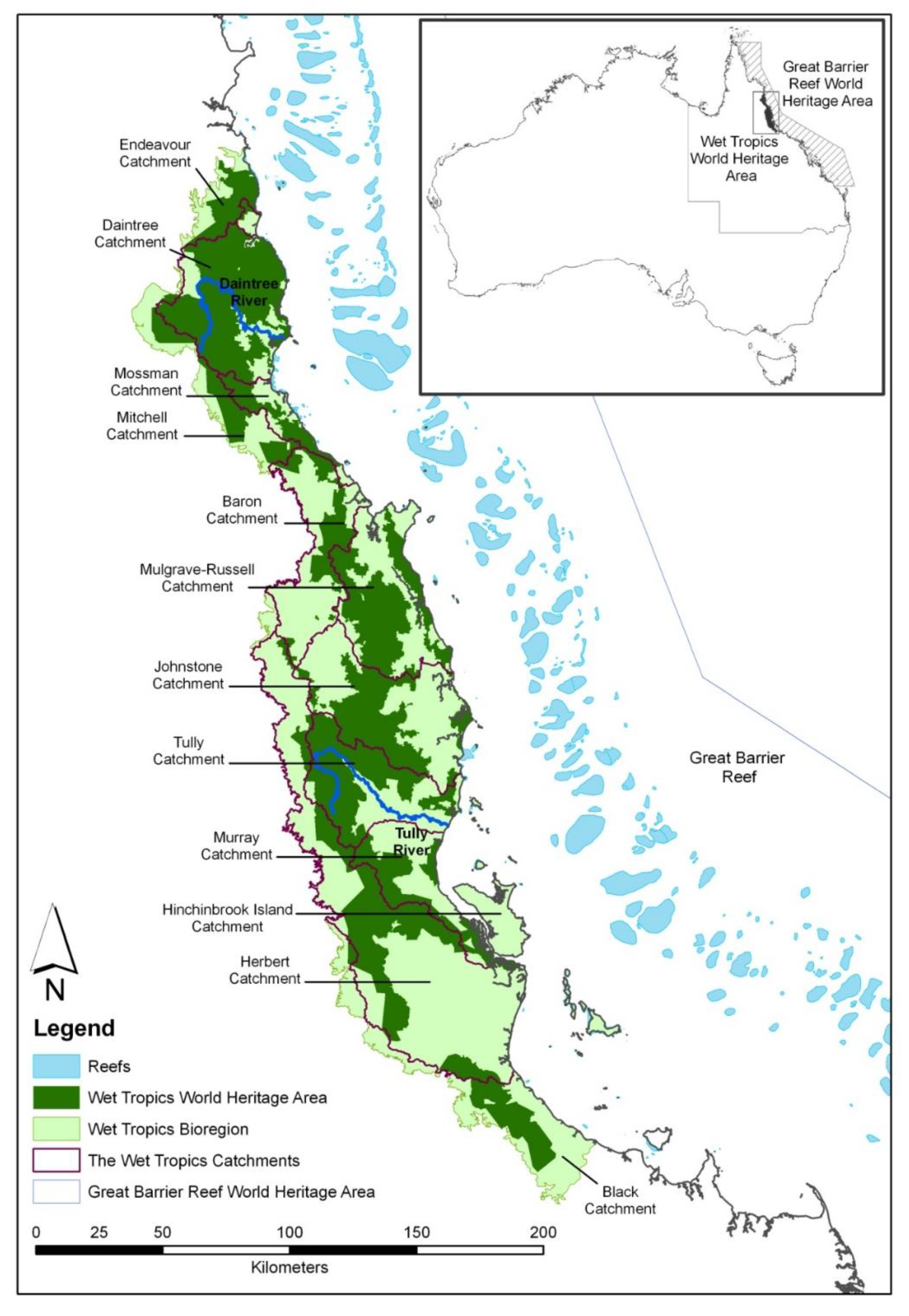
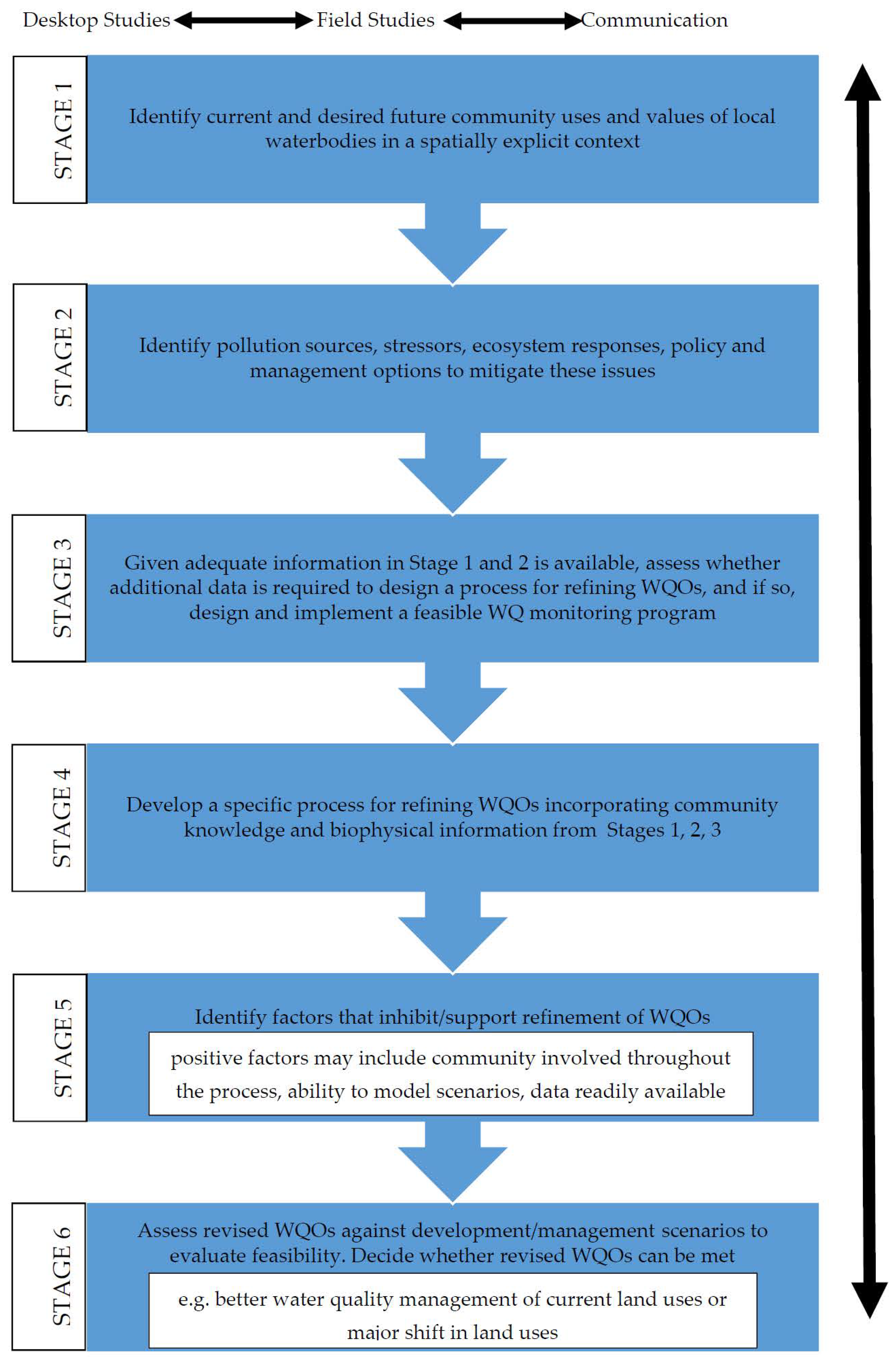
| Parameter | Frequency | Location | Sample Dates (2012) |
|---|---|---|---|
| Total Suspended Solids (TSS) | Once a month (3 times in total) | All 15 stations | May, June, July |
| Turbidity | Once a month (3 times in total) | All 15 stations | May, June, July |
| Pesticides (herbicides--Atrazine, Diuron, Hexazinone) | Once | Three locations | May |
| Total and Dissolved Nutrients (FRP, NH3, NO3, TDN, TDP, TN, TP) * | Twice | All 15 stations | May, July |
| Faecal Coliform Bacteria | Once | Three locations | May |
| Probable Source(s) and Site Condition Class Field Form | Once a month (3 times in total) | All 15 stations | May, June, July |
| Stream Condition Field Form (visual assessment) | Once a month (3 times in total) | All 15 stations | May, June, July |
| Supplemental Field Form (including streamflow measurements) | Once a month (3 times in total) | All 15 stations | May, June, July |
Publisher’s Note: MDPI stays neutral with regard to jurisdictional claims in published maps and institutional affiliations. |
© 2020 by the authors. Licensee MDPI, Basel, Switzerland. This article is an open access article distributed under the terms and conditions of the Creative Commons Attribution (CC BY) license (http://creativecommons.org/licenses/by/4.0/).
Share and Cite
Tsatsaros, J.H.; Bohnet, I.C.; Brodie, J.E.; Valentine, P. Improving Water Quality in the Wet Tropics, Australia: A Conceptual Framework and Case Study. Water 2020, 12, 3148. https://doi.org/10.3390/w12113148
Tsatsaros JH, Bohnet IC, Brodie JE, Valentine P. Improving Water Quality in the Wet Tropics, Australia: A Conceptual Framework and Case Study. Water. 2020; 12(11):3148. https://doi.org/10.3390/w12113148
Chicago/Turabian StyleTsatsaros, Julie H., Iris C. Bohnet, Jon E. Brodie, and Peter Valentine. 2020. "Improving Water Quality in the Wet Tropics, Australia: A Conceptual Framework and Case Study" Water 12, no. 11: 3148. https://doi.org/10.3390/w12113148
APA StyleTsatsaros, J. H., Bohnet, I. C., Brodie, J. E., & Valentine, P. (2020). Improving Water Quality in the Wet Tropics, Australia: A Conceptual Framework and Case Study. Water, 12(11), 3148. https://doi.org/10.3390/w12113148





